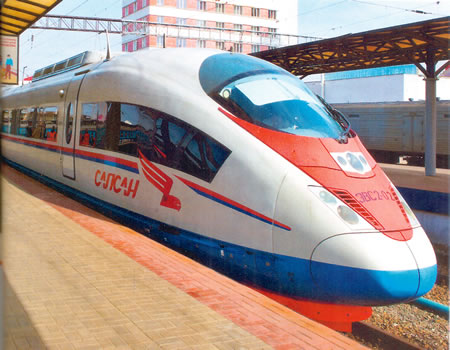I was a long way from home and after a few days watching soccer and sightseeing in Saint Petersburg, I would be heading north by train to the Russian capital city of Moscow.
In Moscow, I would be stopped by the Russian police for a brief interrogation, stung and choked by gas fumes in the Moscow Metro, beaten by a sudden rain shower when I wasn’t with my umbrella, and stared at by some ‘skin head’ Russian youths who were not used to seeing strangers in their land. On the sunny side of things, I would enjoy the company of many football fans who had come for the World Cup, get help from friendly elderly Russian women when communication in English became a challenge, eat delicious meals in roadside restaurants, sip lemon tea in the mornings in my hired apartment and hang out with my two buddies, Tayo and Dion.
At 6.30 that June morning, the Sapsan, a Russian dauge high speed electric express train, slid into track 7 of the Saint Petersburg’s Moskovskiy Railway Station. With its bullet shaped head, the 10 coaches, 250 metre long train, with a capacity for 604 passengers and a maximum speed of 250 km/hr, was a beauty to behold. Sapsan train, which derived its name from the fastest bird in the falcon family, was designed by Siemens AG.
As I waited for it’s arrival, I could not but be captivated by the beautiful work of technology which was a far cry to the steam engine trains of the 60s when my childhood fascination with trains began.
20 minutes after docking, the St Petersburg to Moscow train took off. Travelling the 635km journey with me were my two friends. As we clambered on board the very clean and comfortable train, our International Passports and tickets were checked. It was a lovely train with the seats in the Business Class coach, huge with ample space. There were also facilities to charge our phones and electrical gadgets. The food was also good with nice service.
Anyone who knows Russia will know that train journeys are a quintessential part of experiencing the country and the character of its inhabitants. Most of the passengers were made up of both the old and young who appeared to be students, tourists and businessmen. Hardly had we settled into our seats than two stewardesses handed round the day’s newspapers. Unfortunately, the papers were all in the Russian language. All the same, I got hold of one and tried to use the photographs in the papers to decipher what the news were all about. After the newspapers, came a breakfast of omelette, bread, salad, orange juice and coffee.
Inside the train, all was peaceful as the wonderful piece of engineering marvel became its own little tubular world; a world where rivers and lakes shining in the early morning sunlight slid past the window and the picture square pine forests became a wallpaper on the landscape of our journey. Gradually, the countryside became more rolling and then, suddenly, as the train made a curve, it changed completely: The forest, which for hours had formed a fence on either side of the train, opened up onto broad, beautiful plains, with walls of trees and the sky seemed to pull upward, flooding the scene with light.
In addition, very much unlike my favourite Nigerian trains where you could chat and laugh as much as you like, everything was boringly quiet, with many of the passengers engrossed with newspapers, books, mobile gadgets and sleep. I was left to gaze into the fast changing slices of the Russian countryside while the gentle rocking motion of the train acted as my lullaby and before long, I soon joined some of the passengers in the sleeping business.
When I woke up moments later, I went for a walk down the train to stretch my legs. After two coaches, I stumbled on the canteen where a group of football fans in colourful Colombian jersey were making merry with food, beer and coffee. They were happy to see me in my very popular and beautiful green and white Nigerian jersey and invited me over for a cup of coffee. As we chatted heartily about football and the games, I took in more scenes of the Russian countryside as glimpses of beautiful lakes, rivers, parks and trees flew past the window.
We soon came to the town of Golgoya, where the train stopped for just a minute to discharge some passengers. Moments after we took off again, I was roused from another slumber by a ticket inspector, who glanced at my outstretch ticket and disappeared into the next coach. The train was now going at 200km/hr, probably ascending a hill and before long, we passed Bologoe. Outside Mockba, we passed forests of tall pine and cypress trees as we continued our journey into the vast Russian land, the largest country in the world by land size.
To keep myself busy, I stared out of the window for the umpteenth time as the train now passed several villages scattered across the plain, some dotted with tiny, self-sufficient hamlets.
I was soon brought out of my reverie at 10.40 am by the announcement of the train’s arrival in Moscow. High rise buildings, modern bridges and crowds of people now came into view as the train crawled into the Leningradsky Station.
Moscow is a major political, economic, cultural, and scientific centre of Russia and Eastern Europe, as well as the largest city(both by population and by area) entirely on the European continent. The city is served by a transit network, which includes four international airports, nine railway terminals, numerous trams, a monorail system and one of the deepest underground rapid transit systems in the world, the Moscow Metro, the fourth-largest in the world and largest outside Asia in terms of passenger numbers, and the busiest in Europe. It is recognised as one of the city’s landmarks due to the rich architecture of its 215 stations..
Ironically, it was in the Moscow Metro that I had my most frightening experience in the city. On the second day of our arrival in Moscow, Tayo, Dion and I travelled in the Metro. As we went up the escalator to exit the metro, a wave of gas fumes suddenly stung my eyes and breathing became difficult. A choking sensation erupted from within me and before I knew it, I was seized by a coughing fit. All around me, commuters were coughing and holding handkerchiefs to their eyes to reduce the stinging sensation in their eyes. For a fleeting moment, panic rented the air and people were calling out to the railway officials to do something to mitigate the situation. Just then, all the escalators were redirected to start taking people out of the underground and before long, most of the commuters were safely out on the streets.
On one sunny and hot day, we joined other sweating tourists to visit such historic sites as the majestic Red Square with the Kremlin as well as the colourful St. Basil’s Cathedral and the Armoury Chamber which is the most ancient museum depository in Russia. It was at the Red Square that a Bangladesh Television Station interviewed me on the Nigeria/Argentina match which was slated for the following day.
On leaving the Kremlin, we took the Red Line train in the Metro to the famous Gorky Park, a vast and expansive structure with many facilities such as amusement areas, a large Musical open air auditorium, Library, Theatre and several reception rooms. The facility was named after Alexei Maximovich Peshkov primarily known as Maxim (Maksim) Gorky. He was a Russian and Soviet writer, a founder of the socialist realism literary method and a political activist.
After a few days in Moscow, I returned to Saint Petersburg by the same Spasan train to arrive the Moskovskiy train station after a 5-hour uneventful trip. As we alighted from the train, I noticed a very wide gap between the train and the platform which I considered very dangerous, particularly for older people who may be disembarking from the train with a heavy bag. And even though Muscovites will not agree, I found St Petersburg with its canals and cathedrals, palaces and terraces to be unmatched in its splendour among other Russian cities. Apart from its incredibly beautiful Catherine’s Palace and Peterhof, world-famous Hermitage, Peter and Paul Fortress, Savior on Blood and St. Isaac Cathedral, the city also has other outstanding sights.
For 500 Roubles ($7) I went on a tour of the city aboard a double decker bus with Tayo and Dion. The tour enabled me to see the National Pushkin Museum, the St Petersburg State Capella and the Palace Square. Also visited was The Hermitage Museum. It was at the museum that Tayo stumbled on the historic painting; Roman Charity by Peter Paul Rubens (c 1612) The painting showed a Roman woman, Pero, secretly breast-feeding her father, Cimon, who had been incarcerated and sentenced to death by starvation by the Roman authorities.
I had come to the end of my Russian trip and despite the rigours of the journey I wish I could see more of the vast and mysterious country. And if there was another Sapsan train that could take me back to Nigeria, I would not have hesitated to board it. That is the beauty of a train, this heedless and solitary movement that gets you hooked to the great tubular vehicle.







